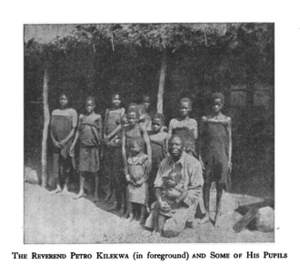Petro Kilekwa facts for kids
Petro Kilekwa (also known as Chilekwa) was a remarkable African man. Born in the late 1860s or early 1870s, he lived until 1967. After being taken against his will and forced to work, he later became a teacher. He then went on to become an Anglican priest, a leader in the Christian church. In 1937, he wrote a book about his life called Slave Boy to Priest: The Autobiography of Padre Petro Kilekwa.
Contents
Petro Kilekwa's Early Life
Petro Kilekwa was born in a village in Zambia. His village was home to the Bissa tribe, near a large body of water called Lake Bangweulu. His birth name was "Chilekwa." He later explained that "Ki-" is a common prefix in the Swahili language.
Taken Against His Will
In the 1870s, when Petro was just a boy, he was captured during what he called "the Maviti wars." This term likely referred to any groups of raiders at the time. His mother tried to get him back, but she could not pay the "ransom." A ransom was a payment needed to free someone. In Petro's case, it was eight yards of calico cloth, which is a type of cotton fabric.
Because the ransom wasn't paid, Petro was taken away. His captors planned to take him to the coast and then across the sea to the Persian Gulf.
However, Petro's journey changed when the ship carrying him and others was stopped by the Royal Navy. This was the British Navy. A ship called HMS Osprey rescued them. Petro and the other people were taken to Muscat, a city by the sea.
After about a month, Petro and another boy named Mambwala were chosen to work on the Osprey. They became seamen, doing small jobs on the ship. The Osprey sailed through the Gulf, looking for other boats that were carrying enslaved people. They even traveled up the Euphrates River to Basra in what is now Iraq.
One day, while the ship was in Persia, some people tried to kidnap Petro and Mambwala. Luckily, they were stopped. Petro also traveled as far as India and saw the sights in Bombay. When the Osprey was going back to England, Petro and Mambwala moved to another ship, HMS Bacchante. They were in Bombay again in 1887 for the Golden Jubilee of Queen Victoria. This was a big celebration for Queen Victoria's 50 years as queen.
Life as a Teacher and Priest
After his time at sea, Petro Kilekwa went to Zanzibar. There, a group called the Universities' Mission to Central Africa helped him. He was baptized, which means he officially became a Christian. He then trained to become a teacher.
Family and Teaching
Petro married a woman named Beatrice Muyororo. She had a similar story to his. She had also been taken against her will and then freed by the British Navy. Like Petro, Beatrice became a Christian and a teacher.
Petro and Beatrice taught together near Lake Malawi. Petro continued his religious studies and became a deacon. A deacon is a church leader who helps the priest. Six years later, he became a priest. He was officially made a priest in June 1917, along with three other men: Leonard Kangati, Lawrence Cisui, and Gilbert Mpalila.
Later Years and Legacy
By 1949, Petro Kilekwa had retired from his work. He lived in a place called Kiungani, in Tanzania. He had a small piece of land that he rented from the government. Petro Kilekwa lived a very long life, passing away in 1967 when he was in his mid-nineties. His life story is an inspiring example of overcoming great challenges.


